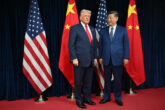May 16, 2018
On China’s New Silk Road, Democracy Pays A Toll
Great power competition is back. And China is now combining its vast economic resources with a muscular presence on the global stage. One of Beijing’s key efforts is the Belt and Road Initiative, a trillion-dollar endeavor to link together Asia, the Middle East, Africa, and Europe through a web of mostly Chinese-funded physical and digital infrastructure.
Much of Washington has fretted over China’s mercantilist approach to economics in general and views the Belt and Road Initiative largely through this lens. Yet the concerns over Beijing’s current approach should go beyond dollars and yuan. By fueling debt dependency, advancing a “China First” development model, and undermining good governance and human rights, the initiative offers a deeply illiberal approach to regions that contain about 65 percent of the world’s population and one-third of its economic output.
The hype surrounding the Belt and Road Initiative — Chinese President Xi Jinping’s signature initiative on the world stage — has recently shifted into overdrive. In China’s domestic politics, support for the project has come to signify loyalty to the country’s president-for-life. At the same time, the Belt and Road serves as an overarching narrative into which Beijing can fit its foreign economic policy in regions as disparate as the Arctic and Latin America. Yet the initiative’s rhetoric and branding should not obscure its core aim: to access markets and project influence and power throughout Eurasia and the Indian Ocean rim. And China has already dedicated significant resources to the effort: Estimates put total Belt and Road-related construction and investment at more than $340 billion from 2014 to 2017.
Read the Full Article at Foreign Policy
More from CNAS
-
North Korea Reveals Troop Dispatch to Russia amid U.S.-South Korea Policy Talks
North Korea has confirmed for the first time that its troops are operating in Russia, and it is preparing to rewrite its party charter with the possibility of officially namin...
By Dr. Go Myong-Hyun
-
Chinese Maker of Bitcoin-Mining Machines Is a Security Threat, Says Expert
Bloomberg News reports that a Chinese manufacturer, Bitmain Technologies Ltd, that sells most of the world’s Bitcoin-mining machines — including 16,000 of them to a venture ba...
By David Feith
-
Indo-Pacific Security / Energy, Economics & Security
North Korea’s Provocations, Power Plays, and Shifting AlliancesTensions on the Korean Peninsula have reached a new and dangerous threshold. President Lee Jae Myung is warning of a real risk of accidental military clashes, as the situation...
By Dr. Go Myong-Hyun
-
Indo-Pacific Security / Energy, Economics & Security
How to Win the Economic War with ChinaTrump's approach to China has run aground, giving Beijing unprecedented advantage in the economic conflict....
By Edward Fishman & Julian Gewirtz



